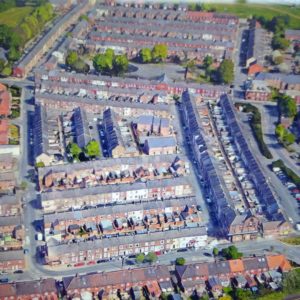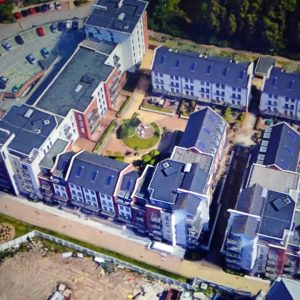
Dr Roger Pierce, former architect, town planner, academic and city councillor, who advises York Civic Trust’s Planning Committee, led a guided walk on Saturday 31st March looking at housing density in York, and highlighting examples of key steps in the development of different housing models. His notes are reproduced below.
York’s history in housing design
York played a part in the revolution of housing design, layouts and density in late Victorian Britain. York-born Dr John Snow’s discovery that the source of cholera was contaminated water supply and other advances led to the Public Housing Act, 1875. This replaced the previous laissez-faire by statutory controls of housing standards and construction. Houses were required to provide through ventilation (thereby ending the construction of back-to-back housing), separate fresh water supply, and their own yards and earth closets (and later wc.s). Public health boards were required to provide drainage, refuse and nightsoil collection, pavements and street lighting. Their by-laws required space and daylighting standards, damp proof courses and inch-inch brick walls.
The resultant ‘two-up, two-down’ terraced house with its kitchen offshot still dominates British house design. The density of these Victorian terraces (for example, at Leeman Road) was 100 dwellings/ hectare.

However, the ‘tyranny of the terraces’ was challenged in York where Raymond Unwin pioneered new housing layouts and designs at New Earswick (and later Garrow Hill) proclaiming: ‘Twelve houses to the acre (30/ha); nothing to be gained by overcrowding’. The terrace and the garden village designs became wedded in the four-dwelling terraces with semi-detached housing at each end and extensive, hedge-lined gardens to the tree-lined avenues in the new council estates at Tang Hall, Bell Farm and Clifton.

York’s draft Local Plan
The deposit York Local Plan policy H1 allocates 35 Hectares of land at York Central (Site ST5) for 1700 dwellings up to 2031 and 800 afterwards. As many as 3,500 were envisaged ten years ago. To ‘ensure efficient use of land’, Policy H2 proposes densities of 100 units/ha within the city centre, 50/ha in the York urban area, 40/ha units in the suburban area and Haxby/Wigginton and 35/ha in villages. Policy H10 requires 20% to be affordable housing in brownfield sites (e.g. York Central) and 30% in greenfields. However, housing density in York Central is anticipated to be determined by further studies.
These densities compare with, at one hand, 30/ha in New Earswick (1903) and, at the other, 250/ha in Hungate (2005-).


Above:- Aldwark (left) 1980’s at 75/ha and Hungate (right) 2005 onwards at 250/ha.
What actually determines housing density?
The determinants of housing density include:-
- Developers preferences – mainly national housebuilders and housing associations.
- National & local values >>>>> party politics >>>> Planning policies especially green belts
- Land Scarcity & Values
- Site development costs
- Central government grant
- The future occupiers and tenure
- Household composition, incomes and lifestyles > market power or political power
- Motor vehicles
- Private or public space < secure by design/ defensible space
- Maintenance and management
- Fashion, nostalgia and how society’s values interpret buildings and surroundings – especially biases for or against urbanism and flats (and the people who live in them)
The economics of land and construction
Currently, the construction cost of a standard two-bedroom, terraced house is £100,000 at a greenfield location. According to Land Registry data, the average price of housing in York in January 2018 was £242,000 . The average price of a flat/maisonette in York in January was £162,000, a terraced property £206,000, a semi £246,00 and a detached house £380,000. Land prices are the difference between the selling price of all the new houses on the site and the sum of the construction cost, site development cost and builder’s profit. Currently, ‘good land’ commands around £1m per acre (an increase from its agricultural land value of £15,000 an acre). Landowners enjoy full rollover tax relief if they reinvest the proceeds in buying new land in two years.
In the interwar and postwar years, councils were able to develop former slum clearance land or outlying greenfield country estates at current use value and received grants towards servicing the capital debt. Subsequently, public subsidy moved from ‘bricks and mortar’ to individual tenants via Housing Benefit designed to target subsidy and to allow rents to rise to market levels. This has enabled social landlords to raise finance for housing from banks. Where affordable housing is required at 20% in brownfield sites, then the developer must sell those houses to a Registered Social Landlord at a ‘bricks and mortar’ cost and reduced land cost. This depresses land prices. Where site development costs are high (e.g. York Central) , then the proportion of affordable housing will be determined by an ‘open book’ examination of viability. Currently, this allows a developers a 20% profit element.
…and a note of space standards
RIBA (The Royal Institute of British Architects) has pointed out that, at 76 square metres, the UK’s average flooorspace, is now the lowest in Europe and has called for a return to the range of statutory standards phased out in 1980s in favour of market determinants and lower construction costs and house prices.
Discussion following the walk
We had, prior to the event, plotted the masterplan proposals over the OS digital data to give a scale masterplan, and had used this to trace the various areas of proposed development and measure their areas in hectares. As a result, we were able to base discussions around some understanding of likely densities which would be required to give the stated Local Plan housing numbers for the site. These appeared to be around an average approaching 200 dwellings per hectare.
Family housing?
One of the key issues which was discussed was the nature of “family housing” and whether this was possible within relatively high-density housing, especially where this led to multi-storey apartments with lift access. We had seen examples on our walk of three-storey (two-storey apartments over shops) and four-storey (Two-storey apartments on top of ground floor two-storey dwellings) both with walk-up deck access, but at the current time lift access would be considered essential and there may be pressure to go beyond four storeys. The shared view was that this would be considered normal in many mainland European countries but was unusual in the UK. It would be useful to research UK examples and gauge their success. Family housing was agreed to be key in creating a community – it was commented that children are the glue which hold communities together, with the school run and shared play areas being key meeting points.
Benefits of higher density living?
We looked at what might be the benefits of higher density living. The main one was easier connections to facilities – it was more likely that shops / public transport / public amenities would be within walking distance. Potentially (subject to design) taller buildings provided good views. But there was concern over the downsides and particularly poor record of UK multi-storey housing – poor sound insulation, high maintenance costs of services and systems, and the general concern that it was only a relatively narrow social mix who wanted to live in them – people without children, but possibly not the elderly who might be isolated by apartment life. The question was asked – “who would want to live here?”
Downsizing?
We discussed the issue of “over-occupation” of family homes by older people – couples and singles whose children had long moved on but who still occupied family homes. We asked what would persuade someone to move from a well-established existing street community into a smaller new home on York Central; the only immediate answer was “it would need to be really high quality and offer something special”. We will do further participative work to explore this.
A tram was also seen as an encouragement as was a better name, as Roger summed it up:
‘New York: the UKs first new garden village with its own tram service’.
Zoning or mixed use?
Discussion highlighted a major problem with the current “zoning” of proposed development, with commercial development with its animation at ground level (bars, cafes, culture) being separated from the residential areas. This separation removed one of the major benefits of higher density – the immediate connection of home and amenities, the short walk from front door to meeting places and the everyday needs of shops and other facilities. Would a greater mix of development (apartments above offices above shops / cafes / bars / culture) offer a better place to live? (This issue had also been identified during our “Public Spaces” events).